Carnation flowers (Dianthus spp.) are cherished worldwide for their vibrant colors, long-lasting blooms, and enchanting fragrance. With a rich history spanning centuries, carnations symbolize love, admiration, and distinction.
From the iconic garden pink to exotic alpine varieties, this guide explores 48 stunning types of carnations, complete with pictures and names to help you identify and choose the best for your garden or floral arrangements.
What Are Carnation Flowers?
Carnations belong to the Dianthus genus, which includes over 300 species. Known for their ruffled petals and diverse colors, carnations are versatile flowers that thrive in gardens, containers, and floral arrangements. They grow in various climates, with some species native to Europe, Asia, and Africa. Carnations are celebrated not only for their beauty but also for their ability to bloom from spring to fall, depending on the species.
Popular Carnation Flower Species
Dianthus carthusianorum
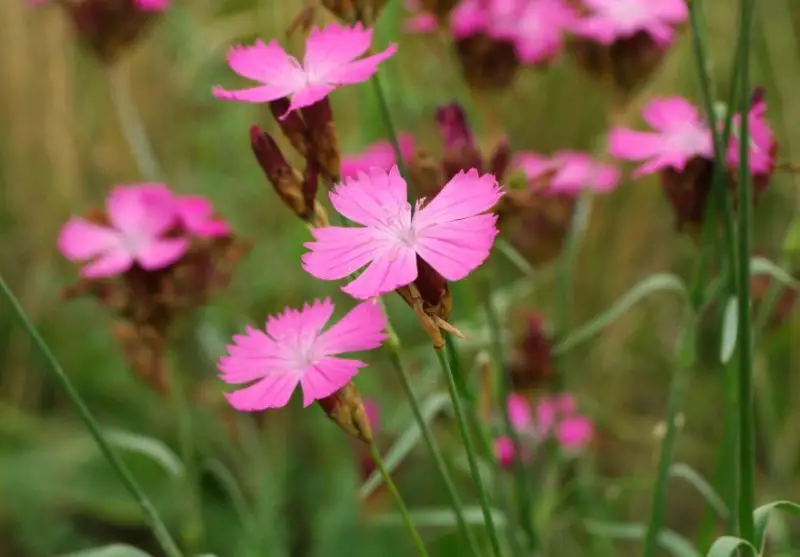
Dianthus carthusianorum, or Carthusian pinks, is a European carnation species that thrives in dry grasslands and mountain slopes. Its dark pinkish-purple flowers with fringed petals bloom in summer, rising above clumps of narrow leaves. Growing between 2 to 3 feet tall, these herbaceous perennials require full sun and well-draining, slightly alkaline soils. Their tall stems and striking flowers make them an excellent choice for naturalized gardens and wildflower meadows.
Dianthus caryophyllus
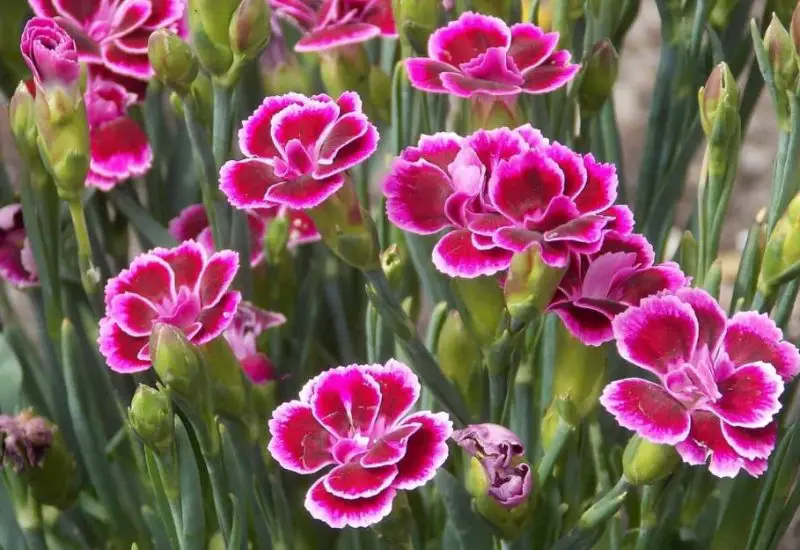
Dianthus caryophyllus, commonly known as clove pink, is among the most popular carnation varieties. Believed to originate from Mediterranean Europe, these flowers have been cultivated for centuries. Their sweet clove-like fragrance and wide color palette, including pink, orange, red, yellow, and white, make them a favorite. Blooming during summer, clove pinks grow between 1 to 4 feet and thrive in full sun to partial shade. They are perfect for both ornamental gardens and fragrant floral arrangements.
Dianthus chinensis
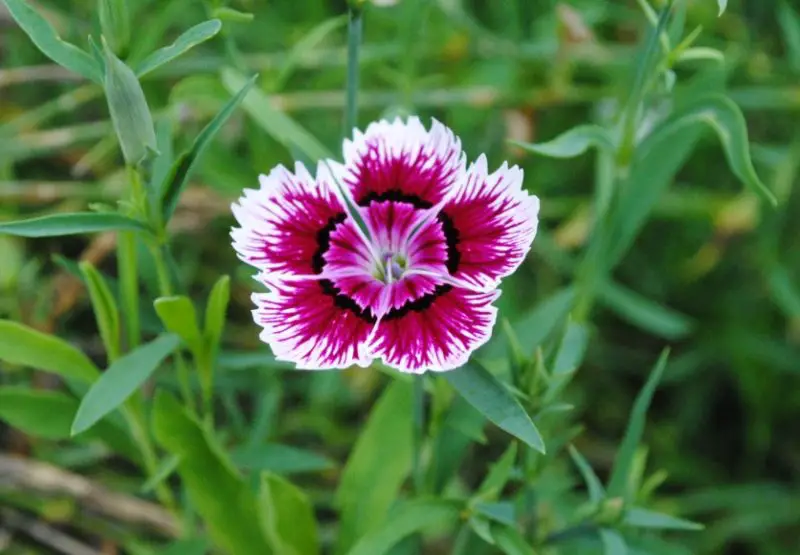
Dianthus chinensis, commonly called the Chinese pink or rainbow pink, is a vibrant carnation species native to the grasslands of eastern Asia. Found in countries like China, Korea, and Russia, these herbaceous perennials grow as bushy plants. Their flowers are typically pink or white with frilled edges and dark red inner petals, and bicolor varieties are also popular. The blooms sit above clumps of slender, grass-like leaves, creating a striking display from spring to fall. Growing to heights of 1 to 2.5 feet, these colorful flowers thrive in full sun to partial shade, making them a favorite in ornamental gardens.
Dianthus deltoides
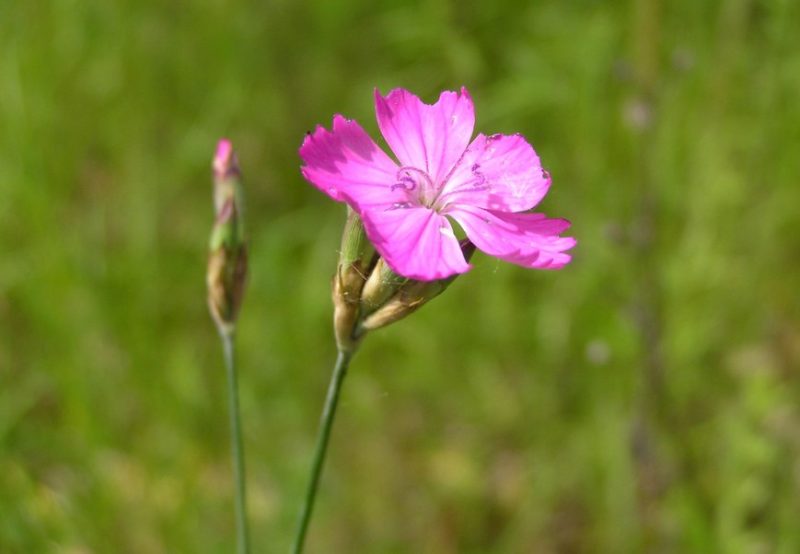
Known as maiden pinks, Dianthus deltoides is native to Europe and parts of Asia but has also become naturalized in North America. These charming carnations are low-growing herbaceous perennials, reaching up to 1 foot tall. Their vibrant pink, star-shaped flowers with frilly edges bloom from late spring to summer. Maiden pinks prefer full sun and chalky, well-drained soils. Their clump-forming habit and bluish-green foliage make them a delightful addition to rock gardens and sunny borders.
Dianthus ‘Everlast Lavender Lace’
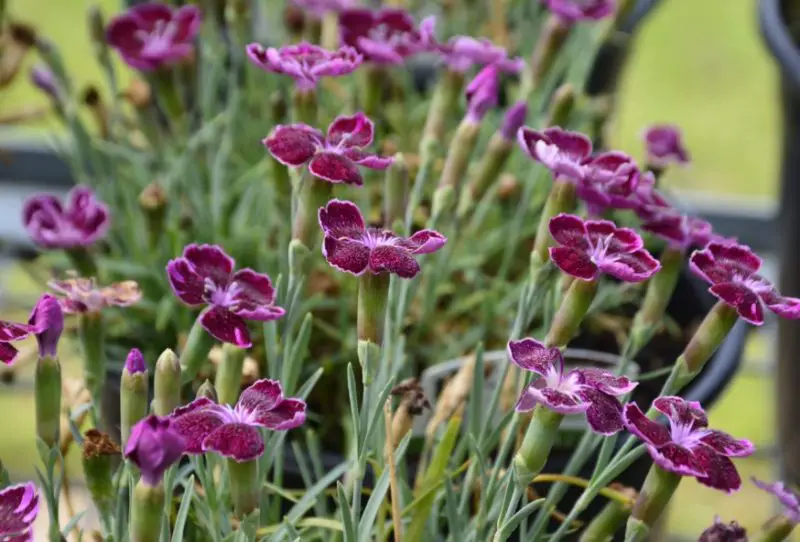
Dianthus ‘Everlast Lavender Lace’ is a hybrid carnation prized for its vibrant, fragrant blooms. This variety features dark reddish-pink flowers with delicate lavender edges, producing a sweet aroma. It’s known for its prolonged flowering season, often blooming two to three times a year from spring to fall. These compact plants, growing up to 1 foot tall, also have slender grayish-green leaves. Thriving in full sun to partial shade, this hybrid is an excellent choice for colorful borders or container gardening.
Dianthus furcatus
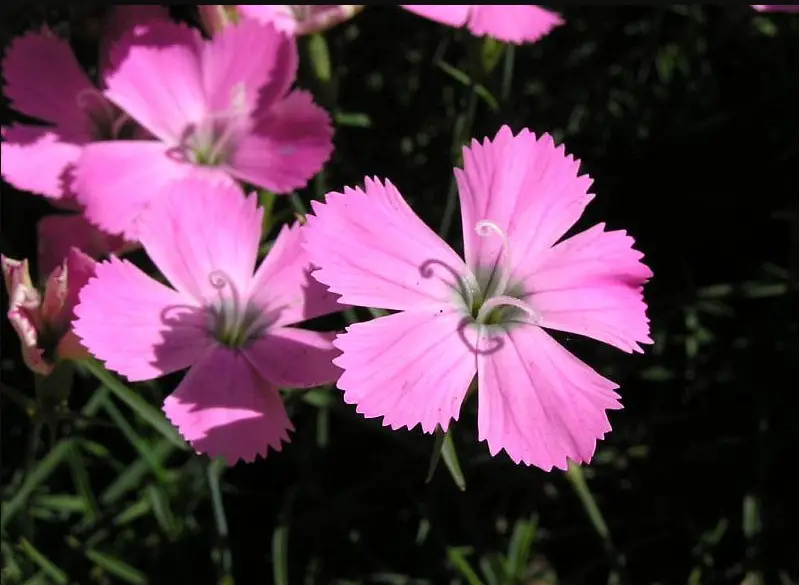
Dianthus furcatus, or the forked carnation, is a native of the French and Italian Alps, flourishing in sunny alpine meadows and grasslands. Its delicate light purple or white flowers with frilled edges sit atop slender stems, forming striking star-shaped blooms. These herbaceous perennials, which grow to heights of 0.5 to 2 feet, also feature bluish-green grass-like leaves. Perfect for rock gardens and sunny slopes, this species thrives in full sun to partial shade.
Dianthus giganteus
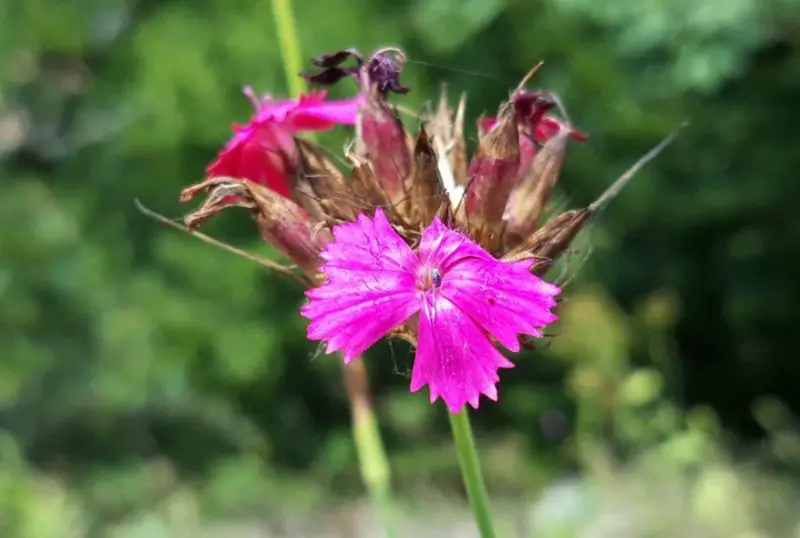
Also known as the giant pink, Dianthus giganteus is a striking carnation species native to the Balkans, including Romania. It grows in grasslands and sunlit slopes, reaching an impressive height of up to 3 feet. This perennial features clusters of small, pinkish-purple, star-shaped flowers with frilled edges that bloom in summer. Its tall stems and vibrant colors attract pollinators, making it a valuable addition to wildflower meadows and large garden spaces.
Dianthus glacialis
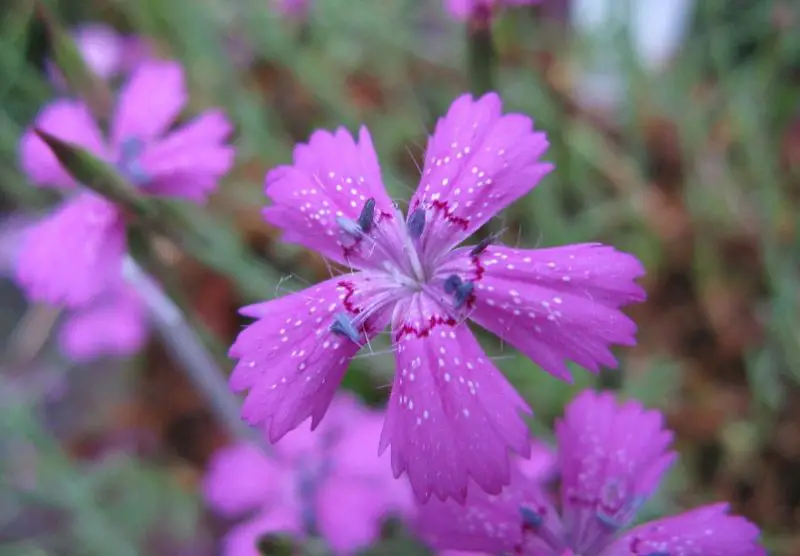
Dianthus glacialis, or glacier pink, is a dwarf carnation variety native to Europe’s alpine regions, including the eastern Alps and Carpathian Mountains. This species thrives on rocky, granite slopes, forming compact clumps of grass-like leaves. Its pinkish-purple flowers, adorned with tufted petals and maroon markings, bloom in summer. Growing to a petite height of just 4 inches, glacier pinks are ideal for rock gardens and alpine landscapes, where their resilience and beauty shine.
Dianthus graniticus
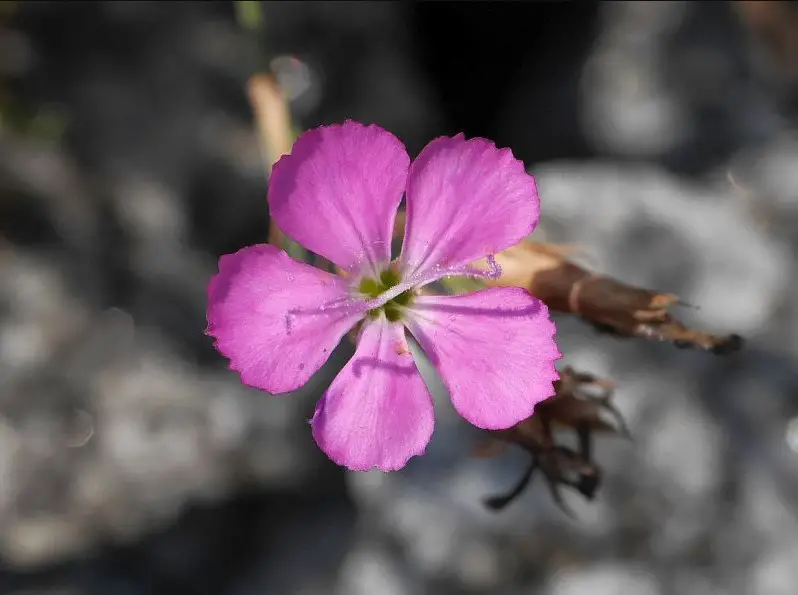
Dianthus graniticus is a rare carnation species first described by French botanist Claude Thomas Alexis Jordan in 1849. Native to central France, it prefers sunny habitats with dry or slightly moist soils. This species features pinkish-purple flowers with frilled edges, perched above slender dark green leaves. Growing to a height of 8 to 15 inches, it’s an excellent choice for sunny borders or naturalistic garden designs, adding subtle charm with its delicate blooms.
Dianthus gratianopolitanus
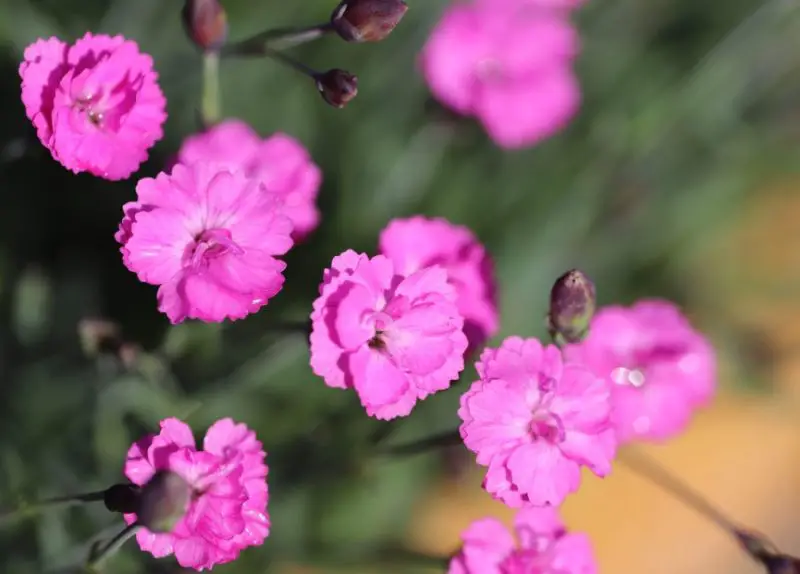
Dianthus gratianopolitanus, also known as cheddar pink or clove pink, originated in Europe and the Cheddar Gorge in the United Kingdom. This perennial thrives in sunny areas with well-drained soils. Its small, fragrant rose-pink flowers with frilly edges bloom from spring to summer, releasing a clove-like scent. Cheddar pinks form dense mats of grayish-green leaves, making them a popular choice for rockeries and cottage gardens.
Dianthus japonicus
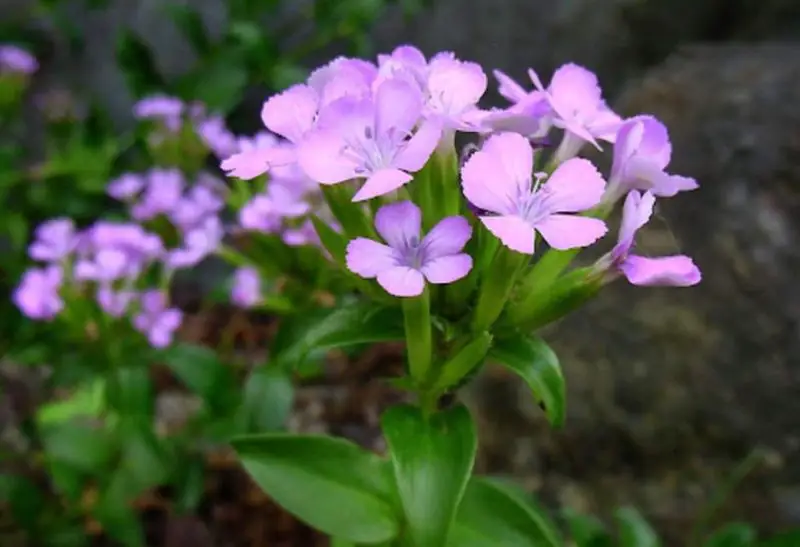
Dianthus japonicus, or seashore pink, is native to the coastal regions of Japan and Korea, thriving on sandy beaches. These carnations produce light pink to white flowers with frilly petals and distinctive pink stamens. Blooming from summer to fall, seashore pinks grow to heights of 6 to 20 inches. Their unique adaptability and stunning appearance make them suitable for both coastal landscapes and cut flower arrangements.
Dianthus knappii
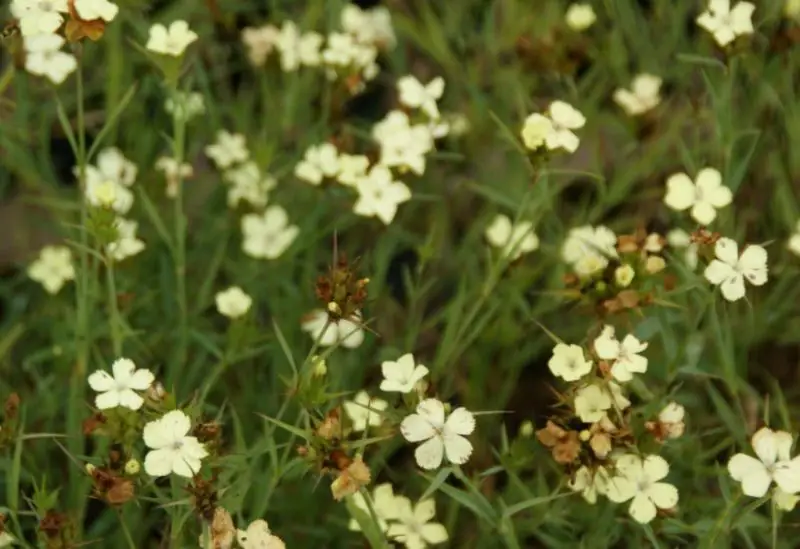
Dianthus knappii, commonly known as Knapp’s carnation, is native to the Dinaric Mountains of southeastern Europe. This species flourishes in dry soils and sunny woodlands. It produces bright yellow flowers with frilled petals on solitary stems, forming colorful mats during spring and summer. Growing up to 15 inches tall, Knapp’s carnation is a unique addition to gardens, standing out with its vibrant yellow blooms against a backdrop of grass-like foliage.
Dianthus lusitanus
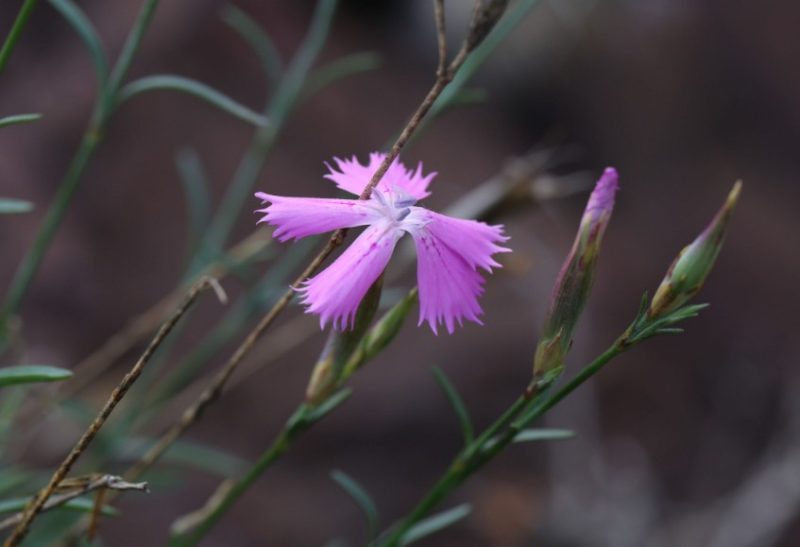
Dianthus lusitanus, commonly referred to as the rock carnation, is native to the Iberian Peninsula, including parts of Spain and Portugal, as well as Algeria and Morocco. It thrives in rocky habitats, forming clumps of bluish-green, grass-like leaves. Its star-shaped pinkish-purple flowers feature serrated edges and dark pink markings. This hardy perennial blooms in spring and summer, reaching heights of 4 to 15 inches. Rock carnations perform best in full sun to partial shade.
Dianthus microlepis
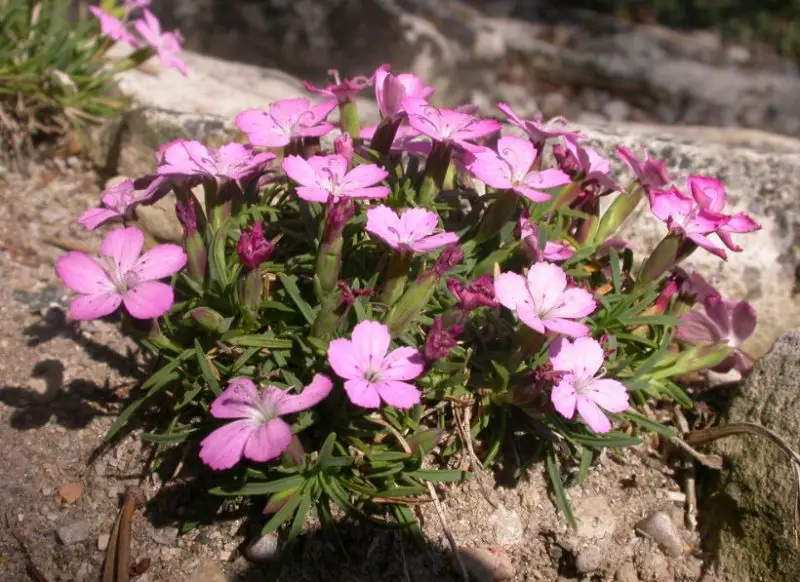
Dianthus microlepis is a low-growing carnation native to mountainous regions of Bulgaria, the Czech Republic, and Romania. This alpine species forms compact clumps of silvery-green grass-like leaves. Its small pink, purple, or white flowers bloom densely during summer, creating vibrant mats. Ideal for rock gardens, this hardy perennial grows up to 4 inches tall and prefers full sun with well-draining soils.
Dianthus micropetalus

Known as the grassveld pink, Dianthus micropetalus is a South African species found in dry grasslands and rocky areas. This clump-forming perennial has slender basal leaves and small, light pink or white flowers with delicate petals. Blooming from November to March in its native range, grassveld pinks thrive in full sun to partial shade and well-draining soils, reaching a height of up to 15 inches.
Dianthus strictus
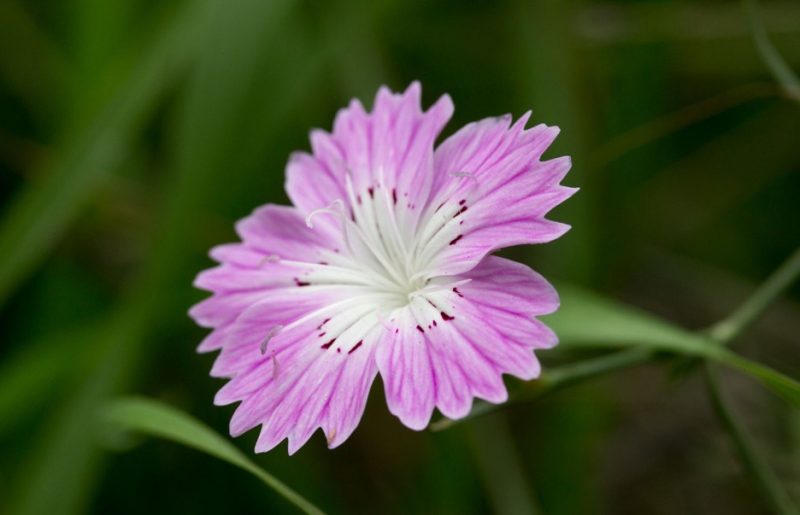
Dianthus strictus, or wild pink, is a clump-forming carnation native to the Mediterranean and Middle East, including Cyprus, Egypt, Greece, and Turkey. Wild pinks have pinkish-purple flowers with purple veins and white centers, blooming from spring to fall. They grow 4 to 8 inches tall in full sun and well-draining soils.
Dianthus subacaulis

Dianthus subacaulis is a low-growing carnation native to southern France. This species forms dense clumps of grayish-green grass-like leaves with upright flower stems. Its pale pink flowers are fragrant and bloom during the summer. Dianthus subacaulis grows up to 2 inches tall in full sun and dry, well-draining soils.
Dianthus superbus
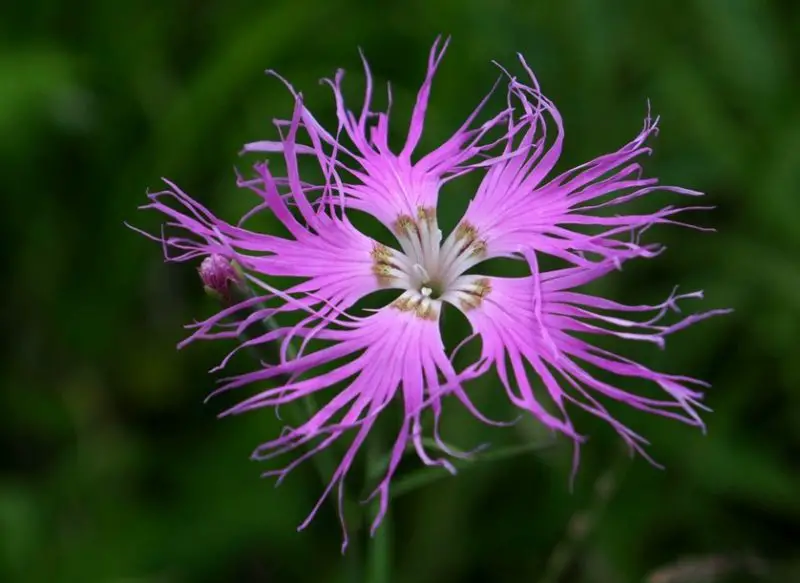
Dianthus superbus, known as the fringed pink or large pink, is native to Europe and Asia, including Japan, France, and Spain. This species thrives at high altitudes, producing pink or purple flowers with long, frilly petals and yellowish markings. It grows 1 to 2 feet tall and blooms in summer, preferring full sun to partial shade.
Dianthus sylvestris
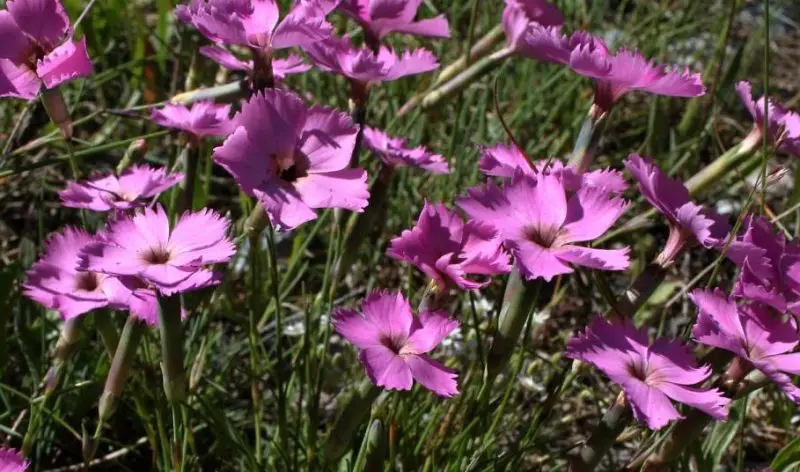
Dianthus sylvestris, or wood pink, is native to the European Alps and parts of Greece. It forms clumps of slender green grass-like leaves and blooms in summer with pink flowers featuring serrated petals and yellow centers. Wood pinks grow 4 to 12 inches tall and are well-suited to dry, stony soils and rock gardens.
Dianthus tenuifolius
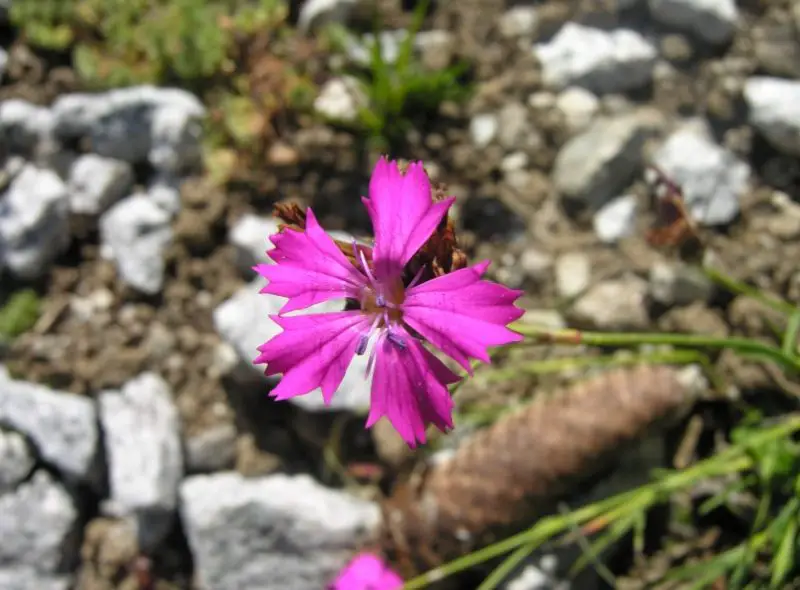
Dianthus tenuifolius, a subspecies of Dianthus carthusianorum (Carthusian pink), is native to the eastern and southern Carpathian Mountains in Romania and Ukraine. It forms clumps of slender grass-like leaves and produces pinkish-purple star-shaped flowers with frilled edges. Blooming in summer, it thrives in full sun and well-draining soils, reaching 2 to 3 feet tall.
Dianthus acicularis
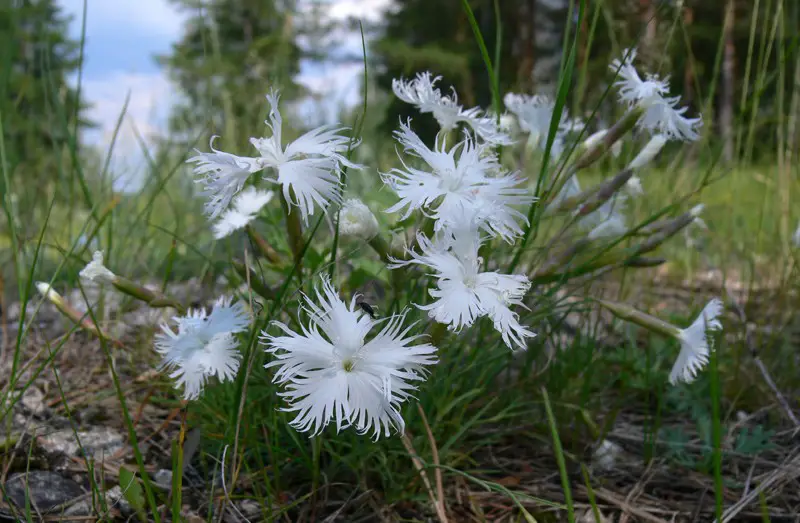
Dianthus acicularis, native to the Ural Mountains of Russia and Kazakhstan, is a charming carnation species often grown for its star-shaped white flowers. The five petals of these blossoms are intricately fringed, creating a delicate appearance. This low-growing plant thrives in grasslands and rocky slopes, reaching a height of 8 to 12 inches. Resistant to bacterial wilt, it is ideal for container gardening or as a cut flower. It flourishes under full sun or partial shade during its blooming season, which lasts from spring to summer, making it a popular choice for sunny landscapes.
Dianthus alpinus
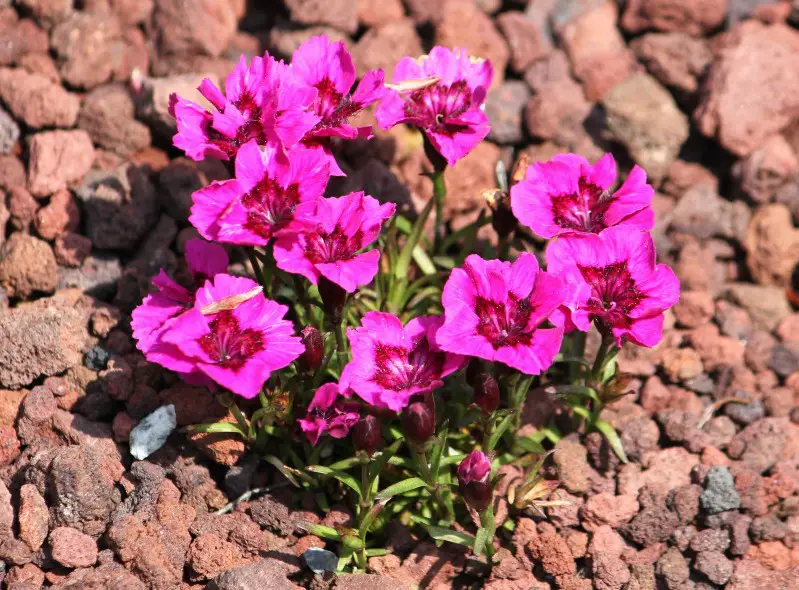
Known as Alpine pinks, Dianthus alpinus is native to the Austrian Alps. These striking carnations display reddish-pink flowers with notched petals and a dark central ring, adding a splash of color to rock gardens. Forming fragrant mats, they bloom from late spring through summer and thrive in full sun or partial shade. Reaching a mature height of only 4 to 8 inches, this low-growing perennial is perfect for small garden spaces or alpine settings where its vibrant flowers create an eye-catching display.
Dianthus arenarius
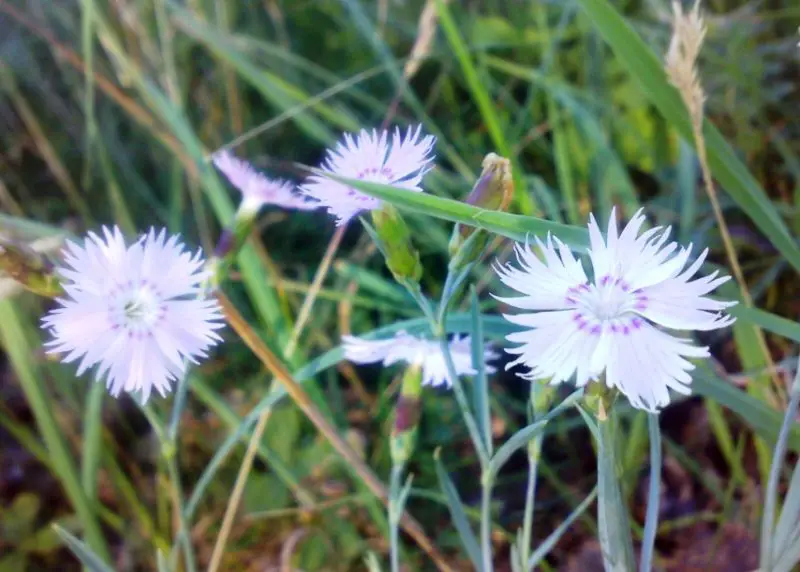
Dianthus arenarius, or sand pinks, is a captivating carnation species found along the Baltic coastline. Its white flowers, with five fringed petals and subtle blue or violet central rings, evoke a sense of understated elegance. Ideal for sandy, well-drained soils, these plants flourish in full sun or partial shade during the summer. Popular in gardens, the cultivar ‘Little Maiden’ is a favorite for its compact growth and delicate blooms. Sand pinks reach a height of up to 8 inches and are a perfect addition to coastal or xeriscape gardens.
Dianthus armeria
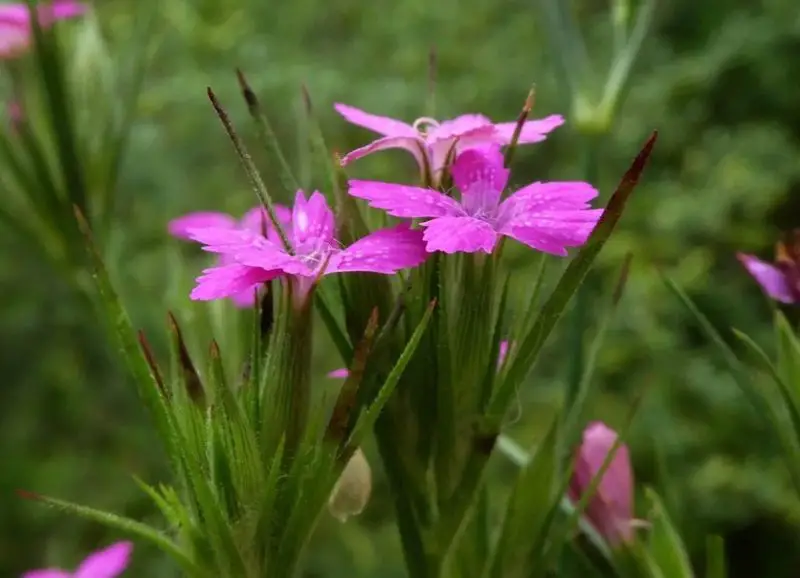
Commonly known as Deptford pinks, Dianthus armeria has vivid pink, star-shaped flowers that brighten gardens and wild meadows. This carnation is native to Europe and has naturalized in North America. With notched petals and a striking appearance, it blooms from spring through fall. Deptford pinks, typically growing between 1 to 2 feet, can thrive as annuals, biennials, or short-lived perennials. Their adaptability and vibrant color make them a beloved ornamental choice in sunny, well-drained settings.
Dianthus balbisii
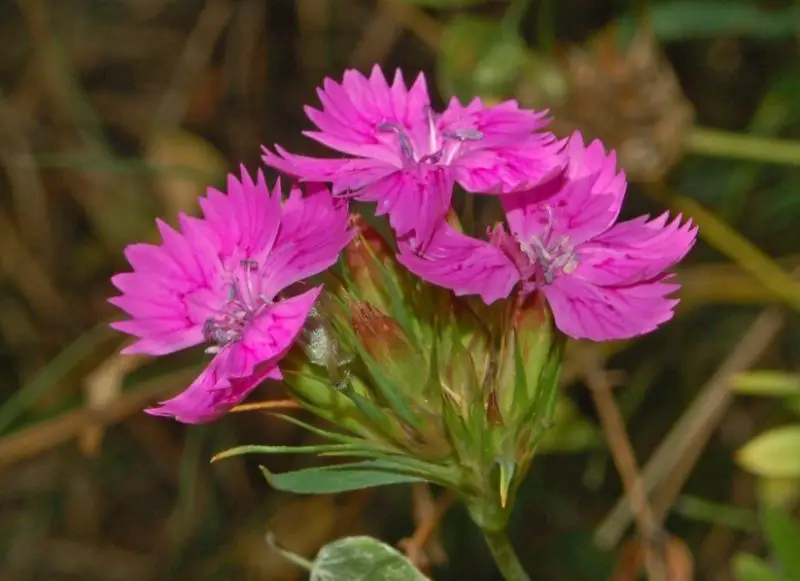
Dianthus balbisii, native to Southern Europe, is a hardy carnation that thrives in dry woodlands and meadows. This herbaceous perennial produces pinkish-purple, star-shaped flowers with frilled petals atop smooth stems. Blooming from summer to fall, Dianthus balbisii grows best in full sun but tolerates partial shade. Reaching heights of 8 to 20 inches, it adds texture and color to gardens while flourishing in nutrient-poor, well-draining soils, making it a resilient and visually appealing plant.
Dianthus barbatus
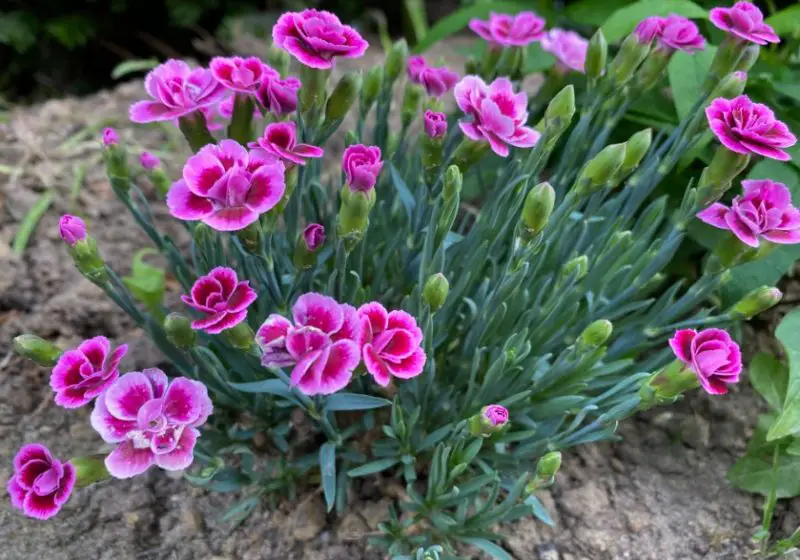
Dianthus barbatus, commonly known as sweet William, is a vibrant carnation originating from Asia and Southern Europe. This fast-growing species produces dense clusters of small flowers in a wide range of colors, including pink, red, white, and bicolor patterns. Blooming from spring to fall, sweet William thrives in full sun and fertile, well-drained soils. With a height of 1 to 2 feet, these carnations are perfect for garden borders and bouquets, delighting gardeners with their prolonged blooming season.
Dianthus bolusii
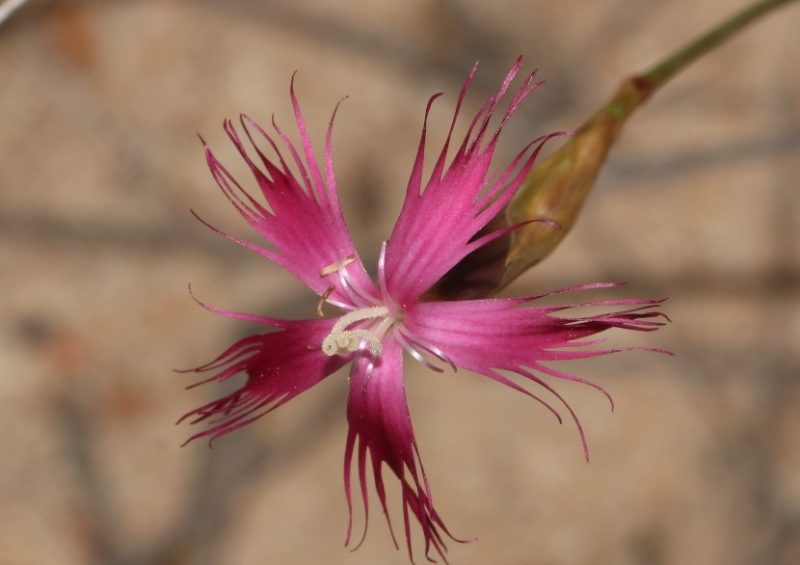
Dianthus bolusii, or mountain pinks, is a unique South African carnation species native to the sandstone slopes of the Cape provinces. These plants grow up to 1.5 feet tall and bear star-shaped flowers in shades of cream, dark pink, or purple. The petals, often adorned with frilled edges and dark red markings, contrast beautifully with the bluish-green foliage. Mountain pinks thrive in dry, sunny environments, making them a captivating choice for xeriscaping or naturalistic garden designs.
Dianthus callizonus
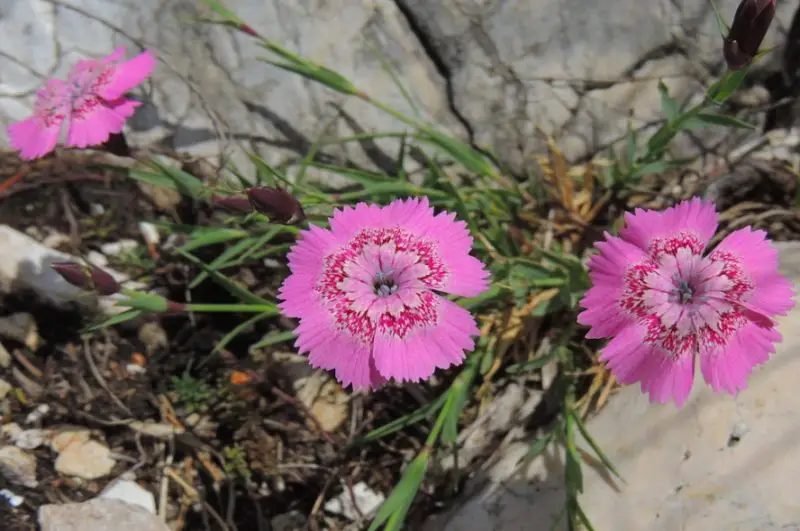
Known as beauty’s girdle, Dianthus callizonus is a low-growing carnation native to the limestone slopes of Romania’s Piatra Craiului Mountains. It produces mats of pinkish-purple flowers with frilled petals and dark red markings, creating a striking contrast. Blooming from spring to fall, these carnations prefer full sun to partial shade and grow to a height of 2 to 4 inches. Their compact size and vibrant colors make them ideal for rock gardens and alpine landscapes.
Dianthus monspessulanus
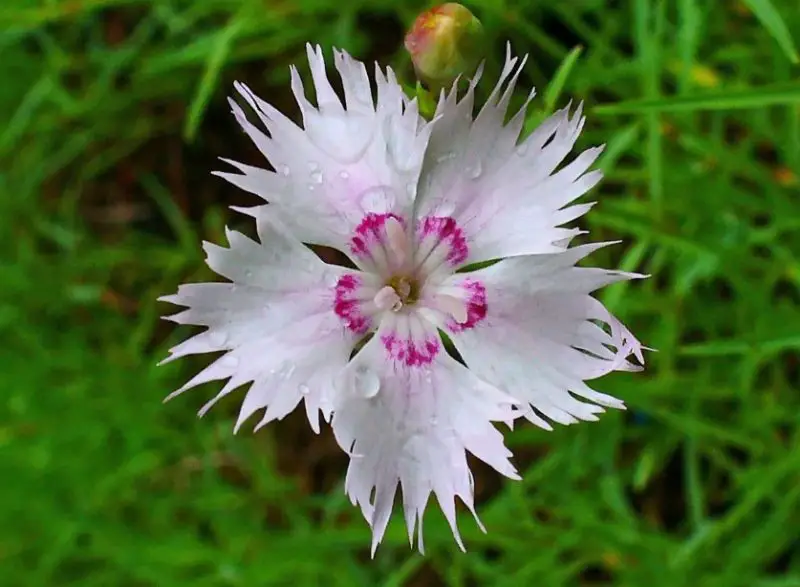
Commonly called fringed pink, Dianthus monspessulanus features pink or white flowers with long, frilly edges. These carnations grow in parts of Europe, including Albania, Austria, and Spain, inhabiting woodlands and dry grasslands. Fringed pinks form clumps of narrow, grass-like leaves and bloom from spring to summer. They thrive in full sun with well-draining soils, reaching heights of 1 to 2 feet.
Dianthus myrtinervius
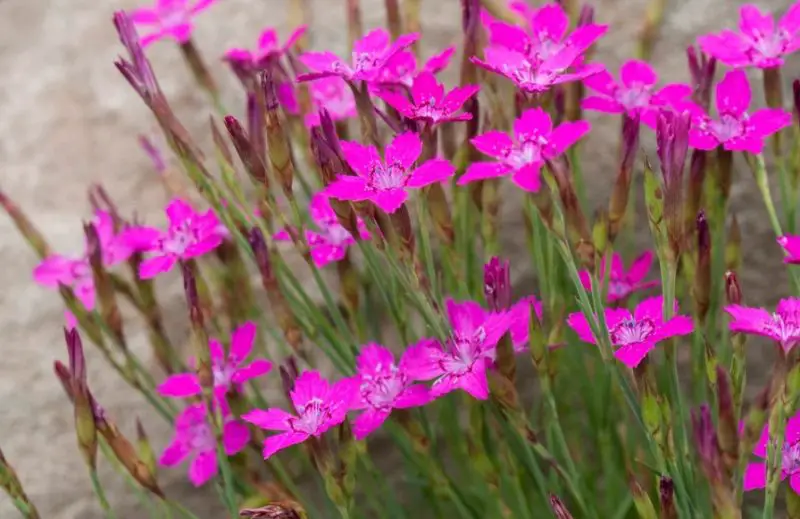
Dianthus myrtinervius, or Albanian pink, is a low-growing species native to southeastern Europe, including Albania and Greece. This perennial forms clumps of bright green grass-like leaves and mats of dark pink flowers with red centers. Blooming in summer, these carnations prefer full sun, sandy soils, and slightly acidic conditions. They grow to a petite height of up to 2 inches, making them perfect for rock gardens.
Dianthus ‘Neon Star’
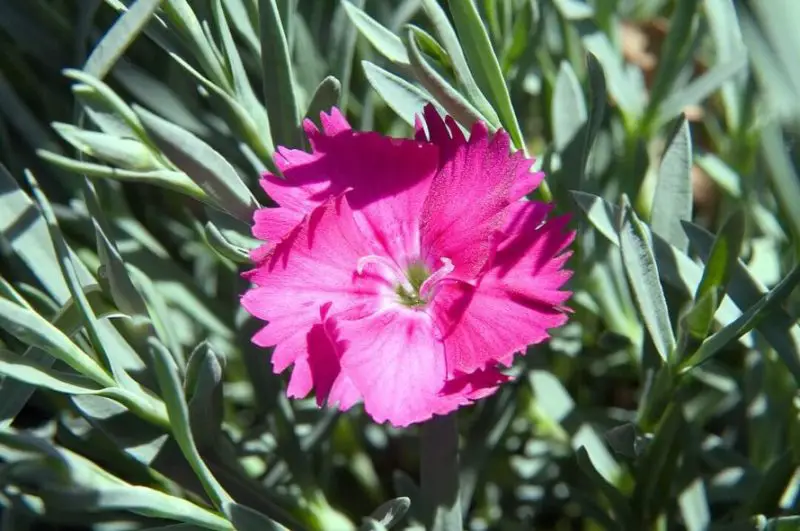
Dianthus ‘Neon Star’ is a cultivar with vibrant pink flowers and a delightful fragrance. It features frilled edges and silvery-blue grass-like leaves, forming compact clumps. This variety blooms from late spring to late summer and thrives in full sun with sandy or rocky soils. Part of the Star Single Series, ‘Neon Star’ reaches a height of 6 to 8 inches and adds vivid color to garden borders or containers.
Dianthus nitidus
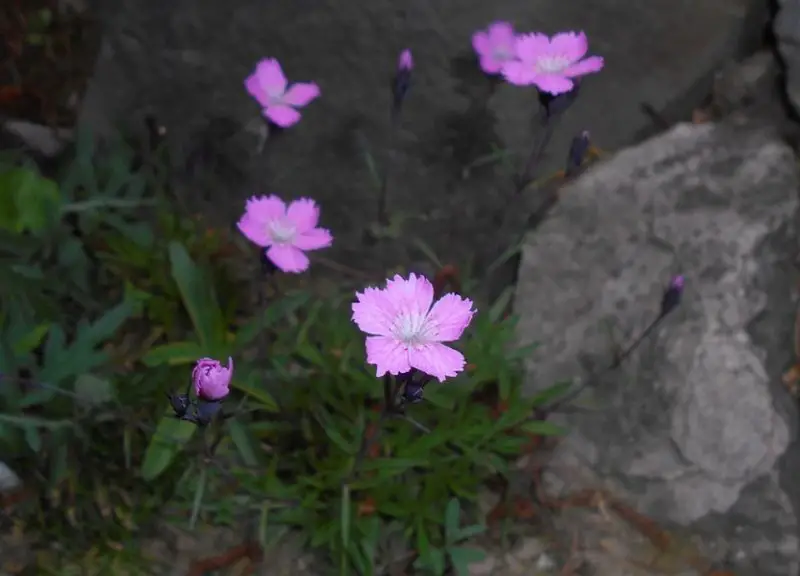
Dianthus nitidus, known as Carpathian glossy pink, is native to the Carpathian Mountains in central Europe. This species produces pinkish-purple flowers with fused petals and clumps of slender, grass-like leaves. Preferring dry soils and full sun, these herbaceous perennials bloom in summer and grow 6 to 12 inches tall, making them a striking addition to alpine gardens.
Dianthus pavonius
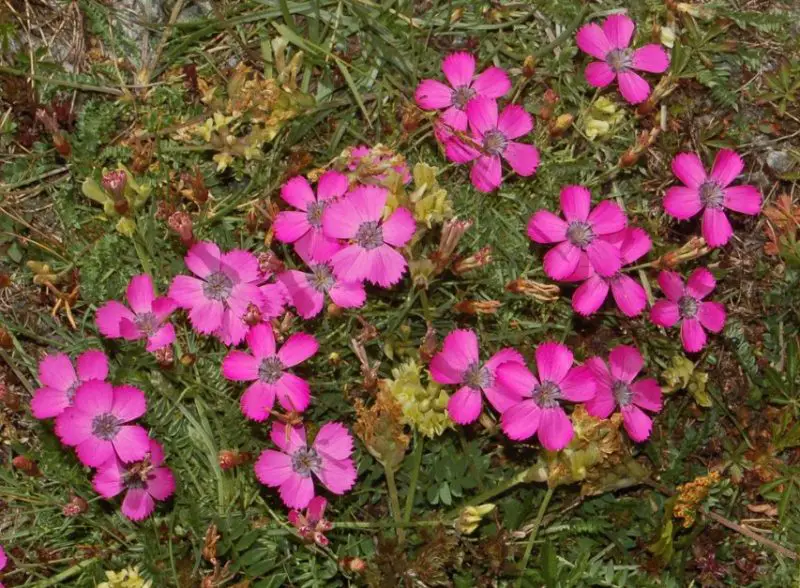
Dianthus pavonius, or peacock-eye pink, grows in alpine regions of France, Italy, and Switzerland. This species thrives in sunny, rich soils and produces pinkish-purple flowers with dark pink centers and frilled edges. Peacock-eye pinks bloom in spring and form clumps of bluish-green leaves, reaching up to 10 inches tall. Their vibrant blooms make them an attractive choice for rock gardens.
Dianthus petraeus
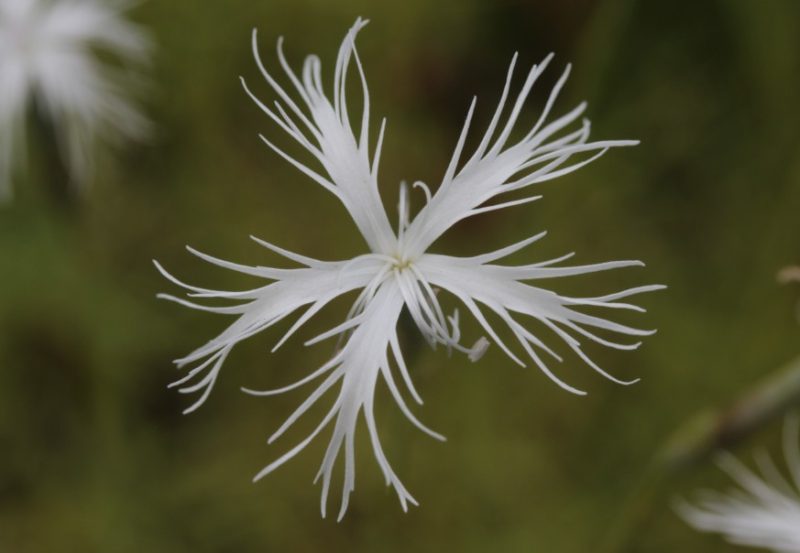
Dianthus petraeus, also called rock pink or fragrant snowflake garden pink, is native to Eastern Europe, including Albania and Romania. It grows in dry forests and rocky areas, forming clumps of bluish-green leaves. Light pink or white flowers with frilled edges bloom in summer. Growing 4 to 6 inches tall, this species is perfect for alpine rockeries, thriving in full sun to partial shade.
Dianthus plumarius
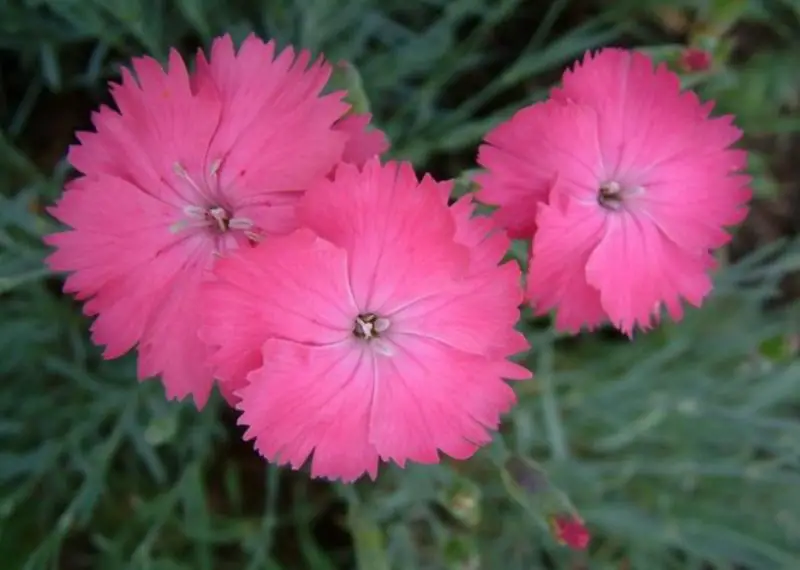
Commonly known as common pink, garden pink, or wild pink, Dianthus plumarius originates from southern Europe and has naturalized in parts of the UK and the US. These carnations feature pink flowers with frilled edges and dark red rings at the center. Growing 1 to 2 feet tall, they form clumps of grass-like leaves. Blooming in spring, common pinks thrive in full sun to partial shade. They may be invasive in certain areas, so local guidelines should be consulted before planting.
Dianthus pungens
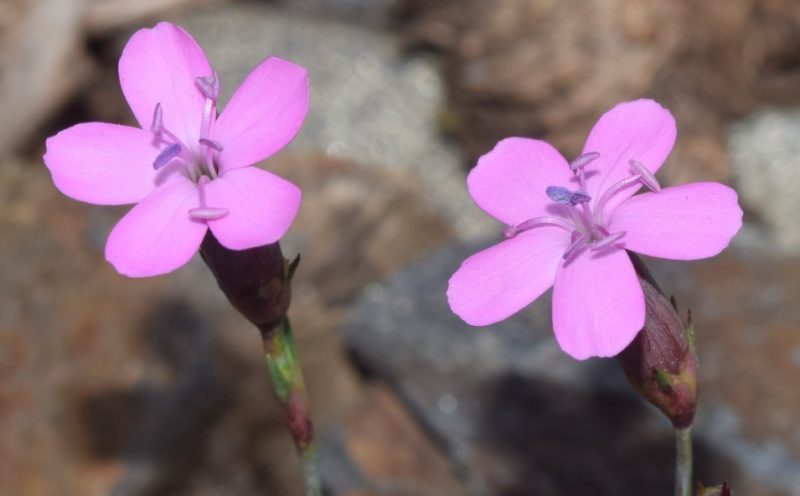
Dianthus pungens is a herbaceous perennial native to France and Spain, especially in the Pyrenees. It thrives in open habitats like grasslands, scrublands, or rocky limestone slopes. This species features pinkish-purple flowers with frilled edges and purple veins, borne on solitary stems above green grass-like leaves. Growing 4 to 12 inches tall, it prefers dry, well-draining soils and full sun.
Dianthus repens
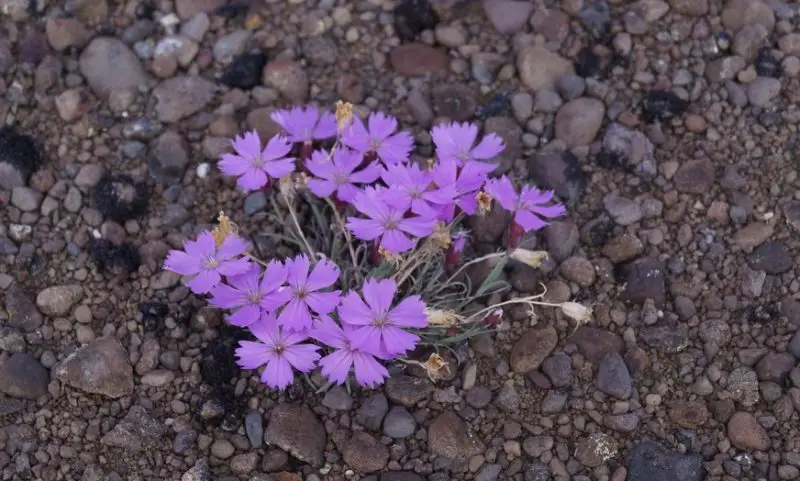
Dianthus repens, also known as the boreal carnation or northern pink, is a compact and hardy species native to China, Mongolia, Siberia, Alaska, and the Yukon. It forms dense mats of grayish-green grass-like leaves and blooms with pink or purple flowers with frilly petals. This species thrives in rocky slopes and full sun, growing up to 8 inches tall.
Dianthus seguieri
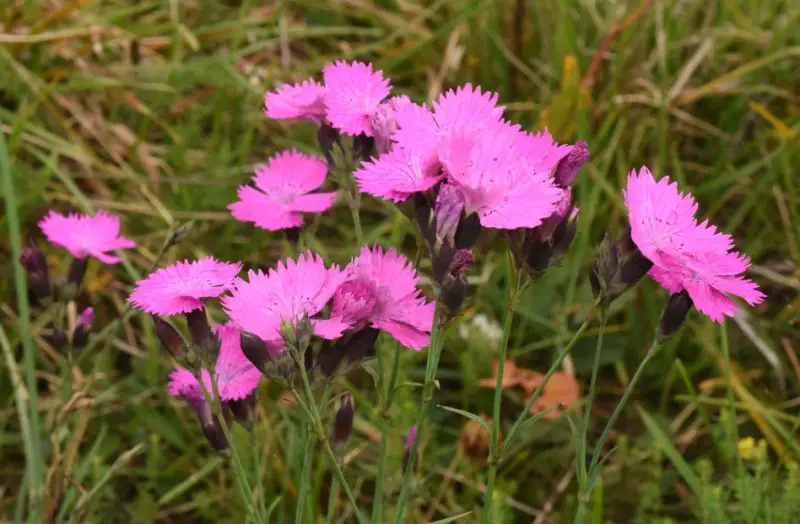
Dianthus seguieri, or Sequier’s pink, is native to central and southern Europe, including France, Germany, Italy, and Spain. It grows in meadows and mountain slopes, producing pink flowers with frilled edges and purple rings in the center. Sequier’s pinks bloom from June to September, reaching 1 to 2 feet tall and thriving in full sun to partial shade.
Dianthus serotinus
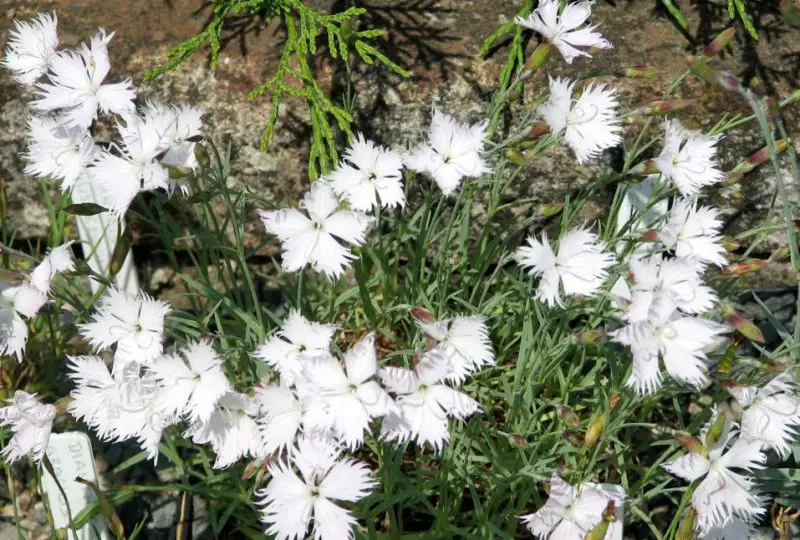
Dianthus serotinus, also called the late carnation or late pink, is native to the Carpathian Basin in Hungary. It blooms from June to October with pink or white flowers featuring frilly edges. This species grows best in sandy grasslands with dry, well-draining soils, reaching up to 8 inches tall. It thrives in full sun to partial shade.
Dianthus spiculifolius
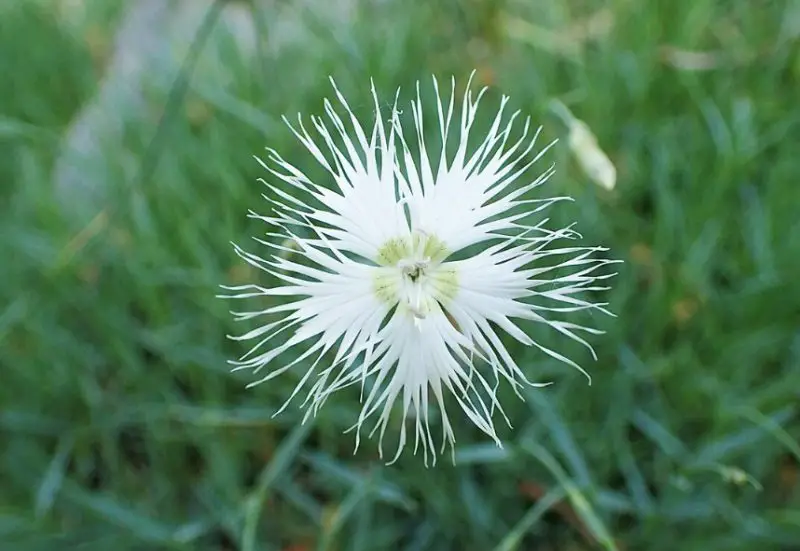
Dianthus spiculifolius, known as the alpine pink, is native to the Carpathian Mountains in Moldova, Romania, and Ukraine. It forms clumps of bluish-green grass-like leaves and blooms from late spring to late summer. The white flowers have frilled edges and dark red spots in the center, growing up to 1 foot tall. Alpine pinks thrive in full sun, making them ideal for rock gardens.






